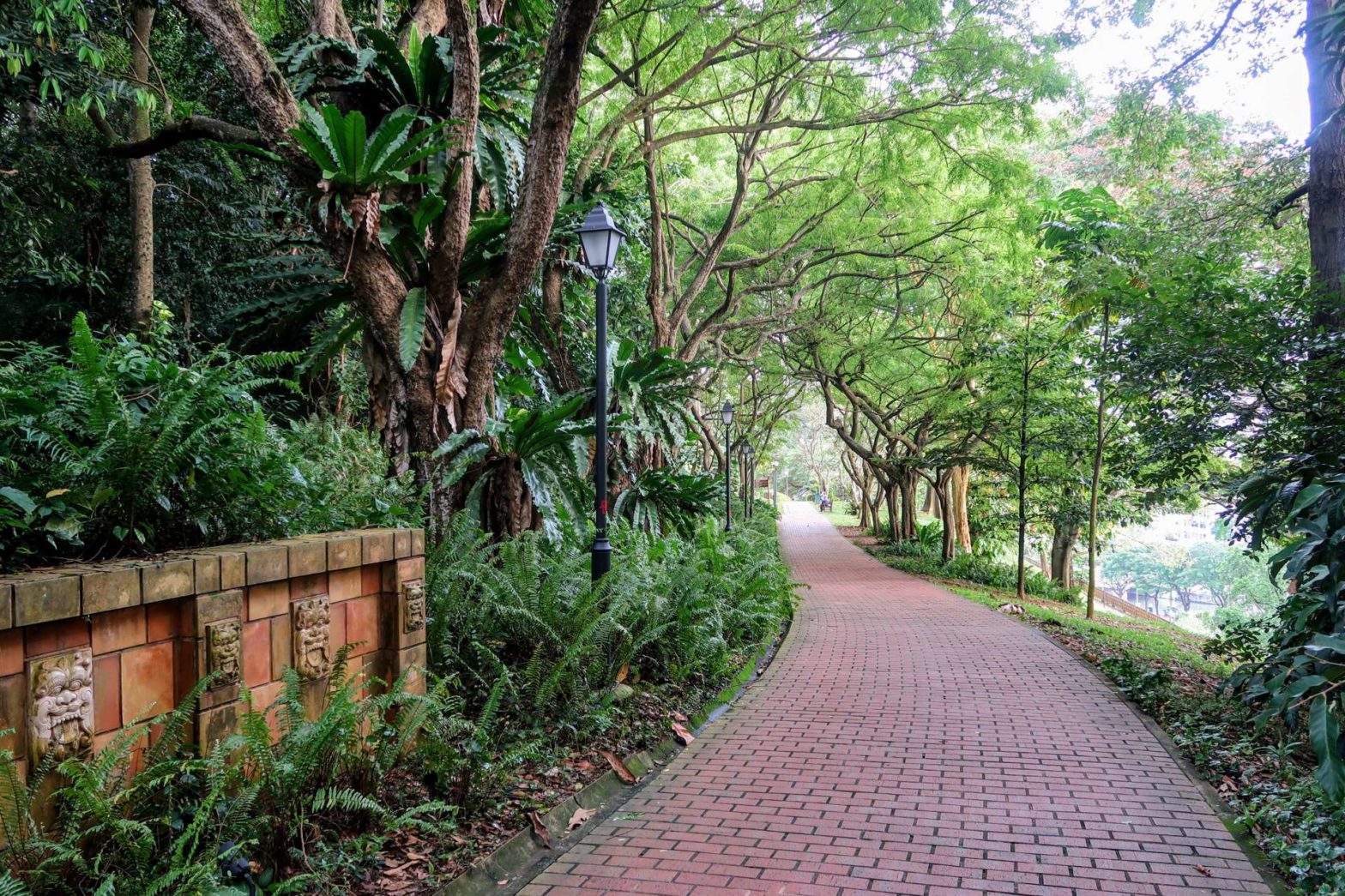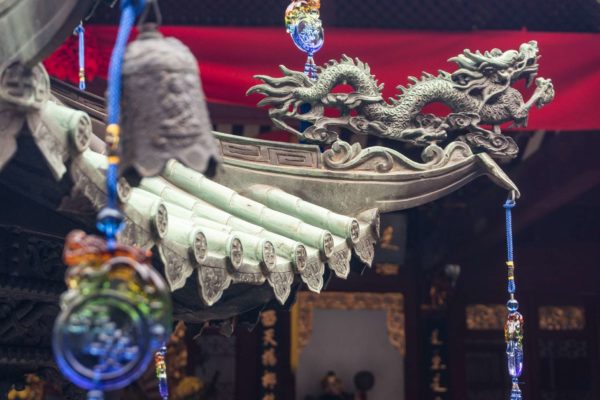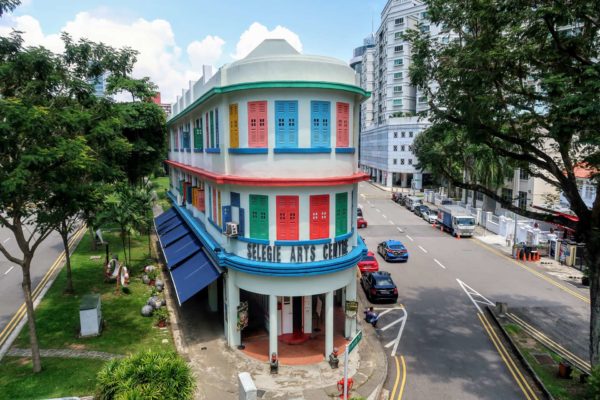By Vicky · Published Feb. 18th, 2022 · Updated Mar. 12th, 2023
When you buy through links highlighted with an asterisk (*) on this site, we may earn a small affiliate commission at no cost to you.
Fort Canning Park is a historic park in central Singapore. It’s full of history, views of downtown and beautiful trees.
Page Contents:
How to get to Fort Canning Park
There are several MRT stations around Fort Canning Park. This walk starts from Dhoby Ghaut MRT and ends at Bras Basah. Dhoby Ghaut is on the Orange Circle, Red North-South and Purple North-East Lines. Leave at Exit B to reach the park. Bras Basah is on the Orange Circle Line. Exit B is closest to the park. Fort Canning MRT station is also close, on the Blue Downtown Line. Leave at Exit B to reach the park.
Fort Canning Park Hiking Trail Map
Get the route by downloading the .gpx or .kml file below. For navigation with Maps.me on your mobile phone, simply download the .kml file and open to add it to the Maps.me bookmarks.
Tips for Fort Canning Park
- Fort Canning Park is open 24hrs and lit 7pm-7am.
- There’s a good amount of shade in the park and sometimes a breeze.
- The National Museum of Singapore* is next to the park if you want to explore further. Orchard Road is also nearby.
- Try walking along the river for a longer hike.
Attractions in Fort Canning Park
On this walking trail you’ll see the main sites and attractions of Fort Canning Park:
- Fort Canning Tree Tunnel
- Pancur Larangan (Forbidden Spring)
- Sally Port
- Battlebox Museum
- Hotel Fort Canning
- Fort Gate and Wall
- Raffles Garden
- Sang Nila Utama Garden
- Archaeological Dig
- Keramat Iskandar Shah
- Fort Canning Centre
History of Fort Canning Park
Being on a hilltop overlooking the river, this area has always attracted past rulers. In the 14th century kings ruled from this high area when it was known as Bukit Larangan, or Forbidden Hill – find out more at the Archaeological Dig site. More recently it served as headquarters of the British Army in the Second World War – visit the Battlebox Museum (buy tickets here*) or read the long but interesting book The Battle for Singapore*.
Fort Canning Walking Trail Route
This walking trail starts from Dhoby Ghaut MRT Station, Exit B.
Directions: From Exit B, head across the small green area and through the small covered bus stop to cross Penang Road. Turn left to head around the big UBS building and you’ll soon reach a signed pedestrian tunnel into Fort Canning Park
1. Fort Canning Tree Tunnel
The tunnel crosses Fort Canning Road and you come out in Fort Canning Tree Tunnel. This is a famous Instagram spot, as many people take photos from the bottom up the spiral staircase to the beautiful tree filling the circular sky above.
Directions: Once done with photos, head up the spiral staircase and you’ll be in the park. Climb up the wide stairs on your right, cross a small road, and then take the first right by the swing chairs to walk along a flat path. Pass underneath the hotel, past a steep staircase on the left, and soon you’ll see the next stop on your left.
Fig Trees and Aerial Roots
There are many magnificent fig trees (species Ficus) in Fort Canning Park. They typically produce aerial roots that hang straight down from their branches to the soil and then transform themselves into what look like new trunks. These are actually just strong roots that provide the tree with nutrients and support the canopy.
But in urban environments, aerial roots find it hard to develop, partly because of air pollution and disturbance, and they rarely reach the ground. In this park, there are several experiments going on to try and support aerial root growth.
2. Pancur Larangan
Pancur Larangan, or ‘forbidden spring’, is a garden within Fort Canning recreated in the style of 14th-century Java. It’s located where long ago the Malay kings’ wives used to bathe and relax amongst the delightful greenery. The surrounding plants, then as now, are those useful in bathing – for fragrance, exfoliation, and rejuvenation. This spring was also an important source of freshwater.
Directions: Head up the covered escalator to the left and whiz towards the high point of the park. Turn sharp right at the signpost and walk past the Fort Gate for now. Head across the grass to the far end where you’ll reach the Sally Port entrance.
3. Sally Port
Head down the mysterious staircase and through the tunnel. This is a sally port – in other words, a secured entrance gate or tunnel into a fortified place. The sally port in Fort Canning is a cool photo spot as jungle surrounds the dark tunnel entrance, with mossy steps leading up to the entrance.
Directions: Turn left to the roundabout and the Battlebox Museum ticket booth.
4. Battlebox Museum
Key Information: Open 9:30am-5:30pm Fri-Sun. Admission only with a 30-minute guided tour ($20) after which you’re free to explore by yourself. Half-price for under 12s. You can buy tickets here*.
This highly-rated museum is in Fort Canning Bunker – where the British High Command made the decision to surrender to the Japanese in WWII. It’s a bomb-proof bunker that has recreations of scenes from the final days leading up to the surrender.
It’s quite fun being underground and hidden in the middle of the park, and you can breathe in the same cold, damp atmosphere as the British generals did when they commanded the Allied forces throughout Southeast Asia.
Directions: Continue walking around on Dobbie Rise, with the grand building of Hotel Fort Canning on your right.
5. Hotel Fort Canning
Hotel Fort Canning was first constructed in 1926, though it wasn’t a hotel back then, it was the headquarters of the British Far East Command which oversaw action here in World War II. There was an easy connection from here to the underground bunkers, known today as the BattleBox, where the important military people could retreat in case of aerial bombardment. In 2002 it became Hotel Fort Canning, a luxury hotel. Today the hotel includes a formal restaurant and a less-formal cafe and bar if you want to have a break from walking.
Directions: Continue heading gradually uphill and soon you’ll turn the corner and face the majestic entrance of the Fort Gate and Wall.
6. Fort Gate and Wall
This gate and the surrounding short section of wall are the only visible remnants of the old part of the fort that gives Fort Canning Park its name. The British built this fort in 1860, named after the Governor-General of India, Lord Canning. Originally this wall, and an additional moat, ran around the entire fort. The walls and fort gate are very thick and filled with granite, brick and earth so they could withstand heavy artillery bombardment from seaborne attacks.
Directions: Head through the Fort Gate and slightly right past the OMSQ (Old Married Soldiers Quarters) building, continue around by the reservoir fence and first left at the signpost. Stroll through the greenery and head to the far end of the park at Raffles Garden.
Camera for Beautiful Photos
I’m a big fan of mirrorless cameras with replaceable lenses. I have a Sony NEX 6, which was one of the first mirrorless cameras from Sony back in 2013. Apart from the kit lens that came with the camera and a telezoom lens that I bought for safari, I bought some cheap second hand but high-quality old lenses from the analogue era from brands like Nikon. With an adapter* you can use these on mirrorless cameras, giving you top quality for cheap. My camera is getting old and I will replace it at some point buy a current model from Sony, like the Sony Alpha A6500:
Sony Alpha A6500 Mirrorless Camera on Amazon*.
Of course, cameras with replaceable lenses and advanced features are not for everyone. We have recently been using a Canon PowerShot G7 X Mark II, which still has some good features and excellent low-light performance, but no replaceable lenses:
Canon PowerShot G7 X Mark II on Amazon*.
Check out the complete list of hiking gear needed for Singapore:
7. Raffles Garden
This garden is named after Sir Stamford Raffles, the founder of modern Singapore and a keen naturalist. Within the garden you can find plants that Raffles may have studied or encountered on his travels in Southeast Asia. You’ll also find the flagstaff and historic Fort Canning lighthouse. Don’t forget to check out the view towards the financial district.
Maritime Corner
A flagstaff has been here at least since 1825. It provided a way of communicating between ships offshore and the merchants onshore. It informed the city what ships had arrived, where they came from and what goods they were carrying.
The lighthouse here played an important role in guiding ships into and out of the harbour below. The first light was actually just a beacon on top of the flagstaff, with the first proper lighthouse in 1903. Even after the Second World War, Fort Canning Lighthouse continued to play an important role, though eventually it closed in 1958 when new tall buildings obscured the view to the ocean.
Directions: From the lighthouse, head slightly downhill towards a majestic rain tree and then left along a path. This will bring you to Sang Nila Utama Garden.
8. Sang Nila Utama Garden
Sang Nila Utama Garden is very evocative and Baliesque. The garden is designed in the style of a Javanese garden from the 14th century and it’s one of my favourite spots in Fort Canning. There are some great photo spots, as this garden has a traditional symmetrical layout, Javanese split gates that separate areas of the garden, and a reflective pool for meditation. It’s full of perfumed and ornamental plants along with a few fruit trees.
Sang Nila Utama Garden is named after a Palembang prince, the legendary founder and former king of Singapore. Sang Nila Utama was the one who gave the name to this city after seeing a lion (or tiger…) in the nearby jungle (Singapura means Lion City in Sanskrit).
This Palembang prince, and other later kings, lived and built their palaces on Fort Canning Hill. Hills and mountains were always associated with divinity and royalty, so by building on hilltops, the kings associated themselves with the gods. Additionally, these places were easy to defend against enemies.
The gardens of the old palaces would have been places of serenity, designed for the use of the king for meditation and relaxation. High walls probably surrounded these gardens to keep the area truly secluded. The current recreation of these gardens still evokes the spirit of what might have been here in the past.
Directions: Continue along the flatter brick path to Artisan’s Garden and you’ll soon see the shelter structure of the Archaeological Dig.
9. Archaeological Dig
Within the Artisan’s Garden is an archaeological dig site where they found evidence for an ancient artisan’s workshop. You can see the archaeological dig and watch a short video (on a continuous loop) about the history of the site. The area is surrounded by some finds from the dig and information boards.
Excavations at the Archaeological Dig found glass fragments and beads from the 14th century. This suggests the area was used by artisans who turned glass into jewellery. Elsewhere on the hill, gold, coins, pottery and more have been discovered, showing Singapore was a bustling trading centre long before Raffles arrived.
The artisans probably had a workshop here because it’s close to the kings and royalty living on the hill. Royalty were some of the few richer people at the time, so those who could afford to patronise the arts and buy goods from the artisans.
Directions: At the far end of the dig head out and left up some steps. You’ll soon see the Keramat on your left.
10. Keramat Iskandar Shah
A keramat is a holy place in Islam. It was thought that Sultan Iskandar Shah is buried here, though evidence now points against it. Iskandar Shah, the last Sultan of Singapore, fled north when his palace here was attacked. He went on to found Melaka, not too far away in Malaysia, and died around 1420. In the 1800s people thought the Sultan was buried here on Fort Canning, though modern research has not found any evidence supporting this. The shrine is, however, still worshipped so be respectful at this site.
Directions: Turn back and immediately left up some steps to the top and head right.
Watch out for the nine-pound cannon, a 19th-century cannon that fired nine-pound cannon balls (about 4 kilograms). It wasn’t actually used for defence but as a timekeeper – shots were fired at 5 am, 1 pm and 9 pm to inform the local population about the time.
Directions: Continue onwards and you’ll see the obvious Fort Canning Centre.
11. Fort Canning Centre
Key Information: Open daily 10am to 6pm, except on the last Monday of the month. Free entry to the galleries.
Fort Canning Centre contains the Fort Canning Heritage Gallery, focussing on the hill’s significance in the history of Singapore. There is also a changing exhibition at Gallery@L3. From the outside you can admire the neoclassical facade of this grand building, built as a British Army barracks in 1926. It’s now at the top of a large, grassy lawn, a great place to sit down to relax and admire the surroundings.
This stop is the last one on this walking tour. There are several MRT stations and bus stops nearby, with the closest MRT being Bras Basah.
Leaving Fort Canning Park
Directions: Head down to the bottom of the large lawn and continue down further to a convenient, colourful escalator at the far end of the Farquhar Garden. At the bottom, you’ll find the National Museum of Singapore on your left. Continue through the greenery, across the road, and Bras Basah MRT Station is just behind the glass SMU library building.
As you head down and out of the park, to Bras Basah MRT or elsewhere, don’t miss the sign pointing out the much older defensive wall of Fort Canning, long before it was ever a British Fort. An earthen wall here in ancient times surrounded the hill and protected the inside. It was 2.75 m high and 5 m wide, so quite significant. A trench parallelling the wall and wooden stakes further up the hill also helped with guarding the royalty who lived above.
Explore Nearby
Walking along Armenian Street is a great way to get to the river (which you can then walk along). It’s a pedestrianised street that leads down to a colourful Children’s Museum and Masonic Lodge, both in lovely buildings, with the Singapore River just beyond.
The National Museum of Singapore is just next to the park. Head in for some air conditioning and to learn about the history of Singapore.
Fort Canning is also close to Orchard Road, explore this busy street with our Orchard Road Walking Trail guide.
If you are interested in other walks nearby, check out Orchard Road Walking Trail, Little India Walking Trail, Kampong Glam Walking Trail, or for more hikes check out our map of walks in Singapore.
FAQS – Fort Canning Park
The park is known for the old Fort Gate and Wall and the many beautiful gardens within the park.
The British built a fort on the hill here and named it after the Governor-General of India at the time, Viscount George Canning. Before that, the hill was known as Bukit Larangan, or Forbidden Hill, because people thought ancient kings were buried here and didn’t want to disturb their graves.
Dogs are allowed in Fort Canning Park and can be let off the lead on the large, grassy lawns in front of Fort Canning Centre.
You are not allowed to cycle in Fort Canning Park.
The easiest way to get to Fort Canning Park is via MRT and there are several stations near the park. Dhoby Ghaut is on the Orange Circle, Red North-South and Purple North-East Lines. Leave at Exit B to reach the park. Bras Basah is on the Orange Circle Line. Exit B is closest to the park. Fort Canning MRT station is also close, on the Blue Downtown Line. Leave at Exit B to reach the park.
Fort Canning Park is unique for its special combination of history and nature. There are several layers of history from both pre-colonial and colonial times, along with a varied collection of trees, spices and flowers from around South-East Asia.
It’s thought that several 14th-century Malay rulers are buried in Fort Canning Park. Today the park is home to a shrine dedicated to Sultan Iskandar Shah, though whether he is actually buried here remains unclear.










